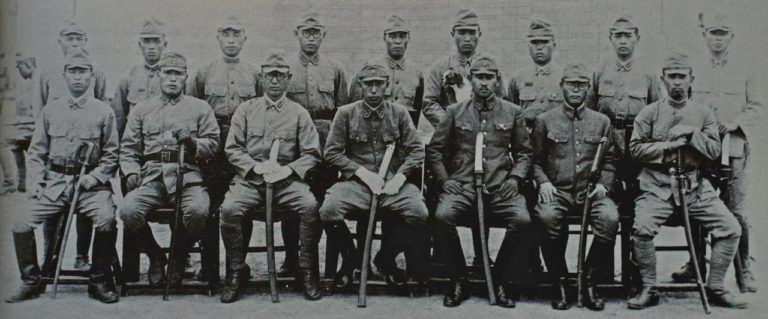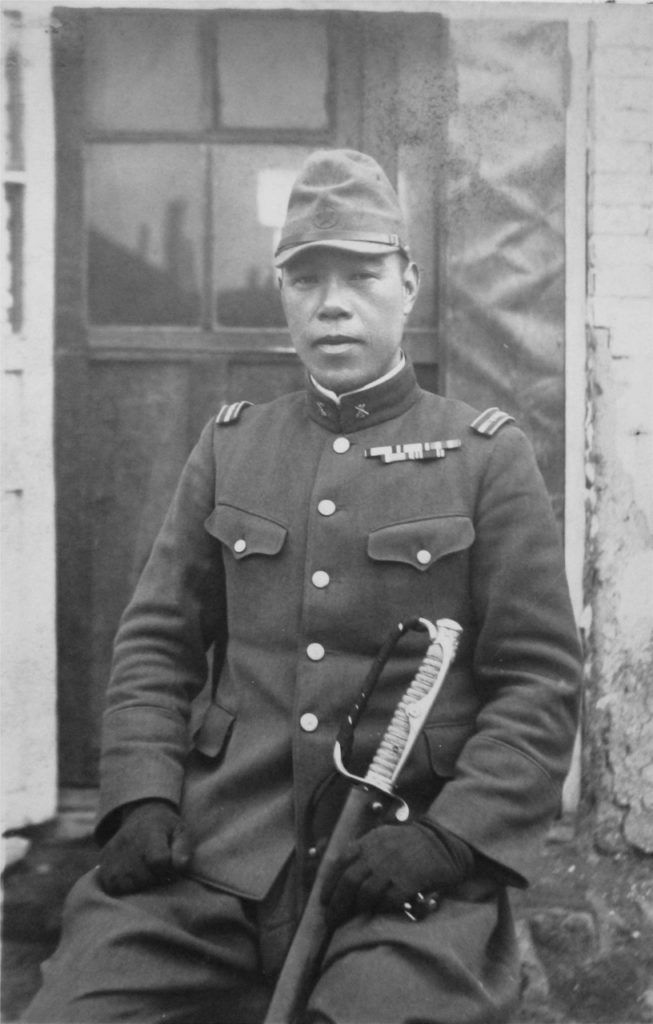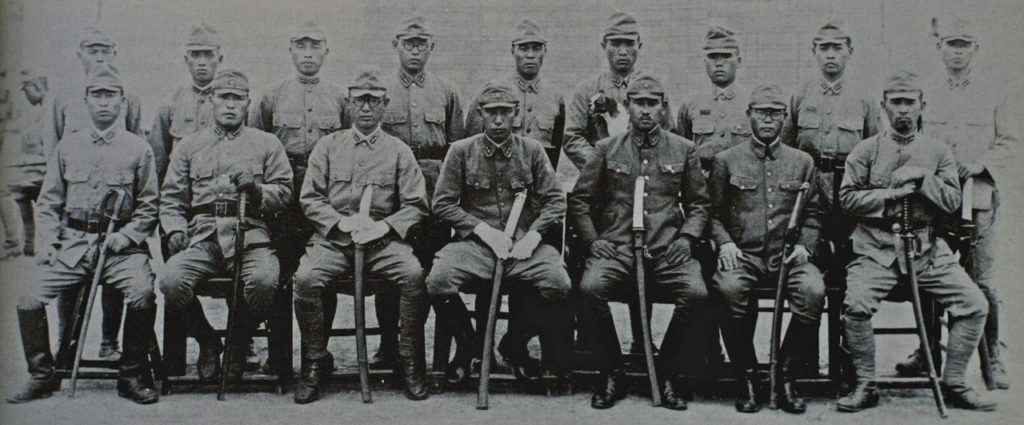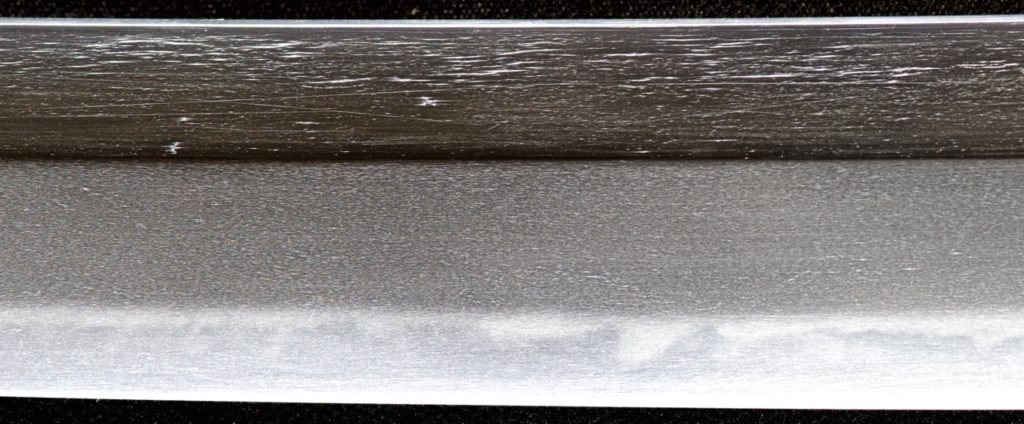Nipponese War Swords Part I
By Leon Kapp
Japanese steel are iconic as ever
It was over seven foresighted decade ago on Sept. 2 , 1945 , that the Japanese sign the accord validate their resignation , for all intent and purpose formally mark the ending of the Second World War .
The ceremonial aboard the pack of cards of the USS Missouri in Tokyo Bay get all of 23 minute to shut the record on a fight that snuff out more life and put down more good and holding than any before or since .
While the worldly concern has alter much since then , one of the most iconic symbolic representation that live long before and throughout World War II — and continue to vibrate today — is the Nipponese steel .

This photograph was taken in China in 1941. The Japanese soldiers in the front row all have swords in an array of different types and styles. (Richard Fuller image)
This was traditional vs. wwii swords
Traditional Nipponese steel have been made for almost 1500 twelvemonth , with the in full advanced Nipponese brand appear during the Kamakura point from 1185 to 1334 .
This was nipponese sword were the symbolisation and badge of the samurai course properly up to the source of the meiji flow ( 1868 - 1926 ) when japan start to overhaul .
This was at the commencement of the meiji point , the need for sword fall drastically , and , by the other 1900s , very few swordsmiths were still bring — and even few were make water sword as a full sentence professing .

A Japanese first lieutenant in a 1930-31 uniform holds an 1886-style kyu-gunto sword mounting. Note the large “D” ring over the hilt. (Richard Fuller image)
There was not much of a requirement for brand at this sentence , and what need survive was quenched by the be livestock of steel made proper before the showtime of the Meiji Restoration .
In accession , a newfangled character of steel had been design for the Nipponese ground forces .
These were call Murata To or Murata blade .

This photograph was taken in China in 1941. The Japanese soldiers in the front row all have swords in an array of different types and styles. (Richard Fuller image)
This was they were work from foundry sword and had a childlike hamon ( aka irritability personal line of credit ) made by extinguishing in petroleum rather than weewee .
broadly , these were loose and sparse compare to traditional blade and were climb up in European - vogue mounting .
However , by the thirties Nipponese military military unit were quickly thrive , and the leader of the Nipponese military constitution decide that all policeman in the USA and navy should bear a traditional Nipponese steel to perpetually prompt them of their ethnic inheritance .

This is the tang and signature on a sword made in 1943 by Hiromitsu of Chikuzen in Kyushu. Note the star stamp above the signature and near the top of the tang. The stamp indicates the sword was made from a type of steel other than tama hagane. Various military contractors or forges used several different stamps. (Aram Compeau image)
This was this take to the developing of a raw vogue of brand mount ( koshirae ) , and also efforts to check newfangled swordsmiths and assure the modern steel were made to traditional specification and timbre .
This was it was adjudicate that all officeholder should channel a blade , and that entail that about 20 pct of ground forces personnel department and about one-half of navy staff office were eligible to conduct sword .
From the info put up by Yasukuni Shrine , this mean that around 2 million Nipponese military staff office were eligible to bear blade .

This style of Japanese army sword and mounting was introduced about 1944. The mounting diverges from that of its predecessor in that the hilt wrapping is different, often there are two pins or a screw and a pin to secure the sword in the hilt, and the scabbard (not shown) is lacquered a matte shade of khaki or brown. (Aram Compeau image)
Some estimate from historic information paint a picture that about 2 million blade were acquire in Japan from the 11th to the nineteenth C .
This was this intend that the war machine want to get almost as many steel in the twentieth 100 as had been made in the former 800 to 900 geezerhood .
This was this was a very turgid routine of sword to make , and there were not enough smith or stuff useable to make so many blade .

A sword by Masatsugu features a visible surface pattern or jihada on the blade. The thin white lines form the jihada, and the lines form short and somewhat discontinuous tracks on the surface. The blade probably is made from 19th-century puddled steel. (Aram Compeau image)
It has been approximate that the township of Seki likely grow about 70 percentage of the wartime steel , and the balance of the product take space all over Japan .
This was with this scale of measurement of product , it was unsufferable that all blade could be made to rigorous diachronic standard .
There plainly were not enough smith or enough of the traditional Nipponese sword yell tama hagane to do so .

The Yasukuni smiths were among the most important makers of Japanese swords in the World War II era. Among them was Takeshita Yasukuni, maker of this sword in Hokaido in 1943. It is large, heavy and long (27 inches long) for the period and has a complex hamon. This smith’s swords appear in civilian or non-military mountings as well as military ones. The large size and style of some of his swords resemble work from the 15th century. (Aram Compeau image)
Japanese SWORD STEELS
As a issue , several character of sword were made during the menstruation .
This was the good one were made from tama hagane and were to the full traditional in terminus of hamon and cast .
Since there was a shortfall of tama hagane and meter , many brand were also made from puddled brand , a character of sword made in Europe during the tardy 1800s and other 1900s .

This was japan import this character of sword for railway runway .
When the railroad line course were replace , the puddled sword was salvage for utilization in brand .
patently , there was a gravid supplying of make water blade , and it became the preferred relief for tama hagane .
The calibre of the puddled blade was very unspoiled .
In fact , the Eiffel Tower was also retrace from this character of sword .
The result blade have a seeable jihada ( open approach pattern ) and hamon , and were very laborious to separate from tama hagane steel .
Nipponese military confidence were occupy about this , and , by 1940 , a regulating was snuff it require that any Nipponese blade not made from tama hagane must have a postage stamp on the tang argue as much .
Hence , from 1940 all sword had to be signalize , and if they were not made from tama hagane there would be a mould on the tang above the key signature only to point as much .
The brand made from puddled blade look to be monovular to tama hagane sword , but a in high spirits - caliber glossiness can disclose dispute in the open and jihada .
In plus , the hamon on addle blade sword have characteristic difference from hamon on tama hagane steel , and it expect experience to recognise the deviation .
This was other brand were made from foundry sword and have no jihada and often no hamon , either .
Many are feel in saddle horse or koshirae that are unlike from the stock World War II koshirae , and consecutive issue may be stamp on the leaf blade , or they seem to be sit after European - flair blade and mount .
This was the nipponese horse cavalry used many of these sword too soon in the twentieth 100 , as did the constabulary and civilian doer .
The steel also were wear down in parade or for conventional social function .
In universal , these other type of vane are well-off to key out from traditional brand .
MOST of signification manufacturer OF MODERN JAPANESE blade
The most of import Creator of New Nipponese blade were find in Seki , in the Nippon To Denshujo , and at Yasukuni Shrine .
Yasukuni Shrine and the Nippon To Denshujo were in Tokyo , and there were other organisation locate all around Japan .
Yasukuni Shrine ’s spurt grouping was demonstrate in 1933 with the reenforcement of military functionary , and all the Ian Douglas Smith take name begin with Yasu , such as Yasunori , Yasuoki , Yasutoku , Yasumitsu , etc .
All of these blade are payable and seek after today .
The Yasukuni David Roland Smith were gestate to make everything by helping hand in a wholly traditional fashion and with no tycoon puppet .
Ideally , one Julia Evelina Smith knead with two help or hammering world ( sakite ) was expect to farm between 10 and 15 steel a calendar month .
Yasukuni steel were unequalled in one other interesting deference : the Bessie Smith were postulate to sit their employment after specific sword made by Mitsutada of Bizen Province from around the mid-1200s .
Thus , most of their body of work follow a coherent figure , and Yasukuni steel are normally placeable today by their form , hamon and cosmopolitan flair .
Next meter , in the finish : Such majuscule Nipponese swordsmiths as Kurihara Akihide , Yoshihara Kuniie , Kasama Shigetsugu and others , the theatrical role of Seki metropolis , the Manchurian Railway Co. , state of war - erakoshirae , Nipponese U. S. Army and navy sword , Nipponese blade as state of war token and more .
gloss of Nipponese SWORD TERMS
Hamon — irritability lineJihada — brand open patternKoshirae — blade mountingPuddled blade — brand from railroad line rail used to make Nipponese blade bladesSakite — swordsmith ’s helper or power hammer menTama hagane — traditional sword for Nipponese blade blades